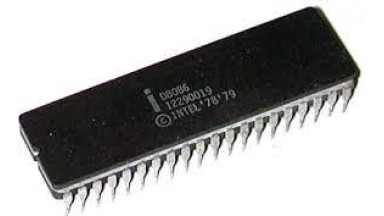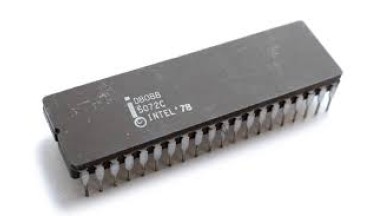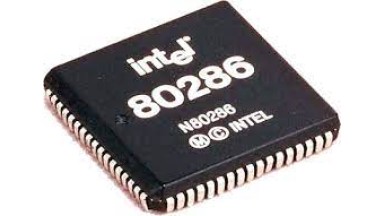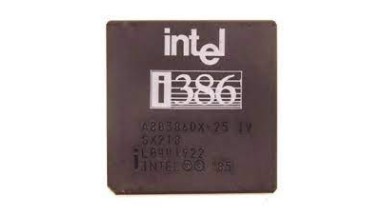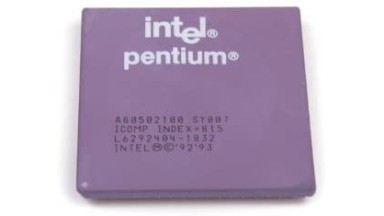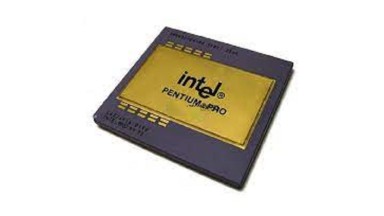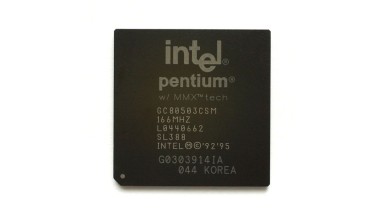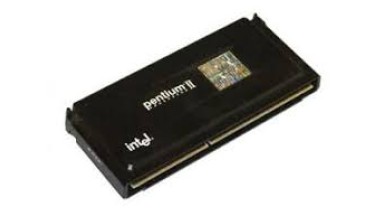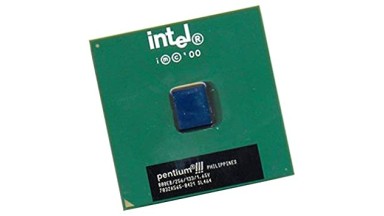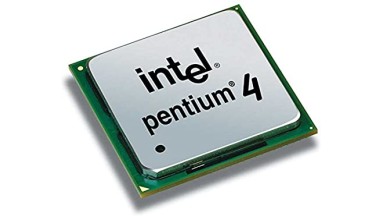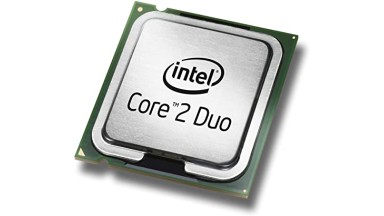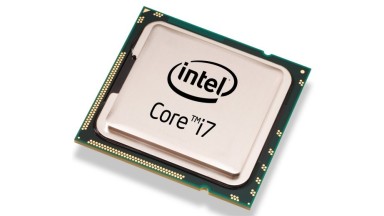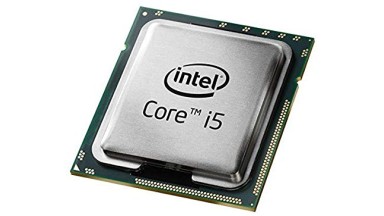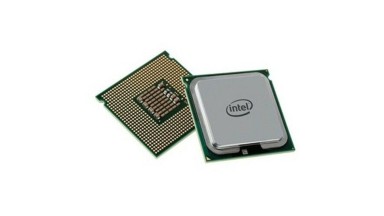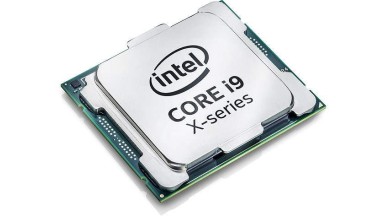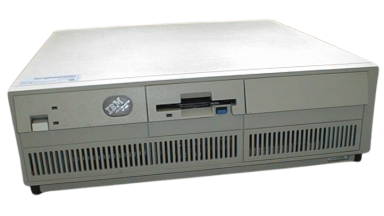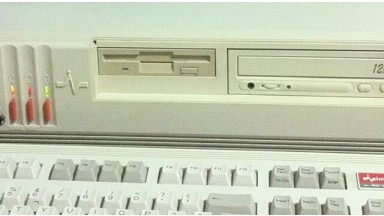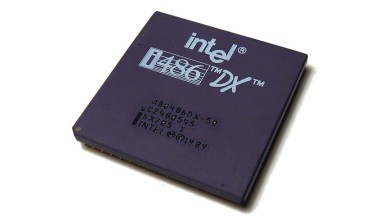
Intel 80486
Intel 80486 microprocessor technical specifications
Developed by: Intel
Launched: 1989
ALU bits: 32
Clock: 16 MHz
until 100 MHz
Family: x86
Bus: 32 bits
Mem. Address: 32 bits
Transistors: 1 200 000
Technology: 1 µm
Voltage: 5 V
The Intel 486 processor was the first to offer an integrated math coprocessor (FPU) that significantly accelerated computing operations.
The Intel 486, officially designated the i486 and also known as the 80486, is a microprocessor introduced in 1989. It is the higher-performance follow-up to the Intel 386. It represents the fourth generation of binary-compatible CPUs following the 8086 of 1978, the Intel 80286 of 1982, and the i386 of 1985.
It was the first tightly-pipelined x86 design and the first x86 chip with over one million transistors.
It offered a large on-chip cache and an integrated floating-point unit.
When announced, initial performance was originally reported as between 15 and 20 VAX MIPS, between 37,000 and 49,000 dhrystones per second, and between 6.1 and 8.2 double-precision megawhetstones per second for the 25 and 35-bit versions. 33 MHz.
A typical 50 MHz i486 executes 41 million instructions per second (Dhrystone MIPS) and a SPEC integer rate of 27.9. It is approximately twice as fast as the i386 or i286 per clock cycle.
The i486's improved performance is due to its five-stage pipeline, all bound to a single clock cycle. The chip's improved FPU was significantly faster than the i387's FPU per clock cycle. The i387's FPU was an optional, standalone math coprocessor that installed in the motherboard socket alongside the i386.
The i486 was succeeded by the original Pentium. Orders for the i486 were discontinued on March 30, 2007, and the last shipments were made on September 28, 2007.
The concept for this generation of microprocessors was discussed with Pat Gelsinger and John Crawford shortly after the 386 processor was released in 1985. The team began computer simulation in early 1987. They finalized the microcode logic and function during 1988. The team finalized the database in February 1989, leading to tape output on March 1. They received the first silicon from manufacturing on March 20.
The i486 was announced at the Spring Comdex on April 10, 1989. In the announcement, Intel stated that samples would be available in the third quarter and that production quantities would ship in the fourth quarter. The first i486-based PCs were announced in late 1989.
In the fall of 1991, Intel introduced the 50 MHz i486 DX using the 800 nm three-layer CHMOS-V process. They were available for $665 in quantities of 1,000.
During that time, Intel introduced the low-power 25 MHz Intel486 DX microprocessor. This was available for $471.
Low-power Intel486 SX microprocessors were also available at 16, 20, and 25 MHz. They were available at $235, $266, and $366 for these frequency ranges, respectively. All prices were in quantities of 1,000. The power consumption of these low-power microprocessors was reduced by 50–75% compared to similar mainstream versions of these CPUs.
At that time, Intel introduced the 25 MHz Intel 486 DX low-power microprocessor. This was available for $471. There were also low-power Intel 486 SX microprocessors at 16, 20, and 25 MHz. They were available at $235, $266, and $366 for these frequency ranges, respectively. All prices were in quantities of 1,000 units. These low-power microprocessors have a power consumption reduction of 50–75% compared to similar mainstream versions of these CPUs.
The first major update to the i486 design came in March 1992 with the release of the clock-doubled 486DX2 series. It was the first time that the CPU core clock speed was separated from the system bus clock speed through the use of a double clock multiplier, supporting 486DX2 chips at 40 and 50 MHz. The faster 486DX2-66, at 66 MHz, went on sale in August.
The fifth-generation Pentium processor was released in 1993, while Intel continued to produce i486 processors, including the triple-clocked 486DX4-100 with a clock speed of 100 MHz and an L1 cache doubled to 16 KB.
AMD's 486 Copy
Previously, Intel had decided not to share its 80386 and 80486 technologies with AMD. However, AMD believed its technology-sharing agreement extended to the 80386 as a derivative of the 80286. AMD reverse-engineered the 386 and produced the 40 MHz Am386DX-40 chip, which was cheaper and powered less than Intel's best 33 MHz version. Intel tried to prevent AMD from selling the processor, but AMD won in court, allowing it to establish itself as a competitor.
AMD continued creating clones, releasing the first-generation Am486 chip in April 1993 with clock speeds of 25, 33, and 40 MHz.
The second-generation Am486DX2 chips, with clock speeds of 50, 66, and 80 MHz, were released the following year. The AMD486 series was completed with a 120 MHz DX4 chip in 1995.
In 1995, AMD settled its long-running 1987 arbitration dispute with Intel and gained access to Intel's 80486 microcode, leading to the creation of two versions of AMD's 486 processor: one reverse-engineered from Intel's microcode and one using AMD's microcode in a clean-room design process. However, the settlement also concluded that the 80486 would be AMD's last Intel clone.
Cyrix's 486 clone
Another 486 clone manufacturer was Cyrix, a manufacturer of fabless coprocessor chips for 80286/386 systems. Cyrix's first 486 processors, the 486SLC and 486DLC, were released in 1992 and used the 80386 package. Both Cyrix processors, manufactured by Texas Instruments, were compatible with 386SX/DX systems, making them an upgrade option. However, these chips could not compete with Intel 486 processors, as they only had 1 KB of cache and no built-in math coprocessor.
In 1993, Cyrix released its own Cx486DX and DX2 processors, whose performance was closer to that of their Intel counterparts. Intel and Cyrix sued each other, Intel for patent infringement and Cyrix for antitrust. In 1994, Cyrix won the patent infringement case and dropped its antitrust suit.
In 1995, both Cyrix and AMD began looking for a ready market for users who wanted to upgrade their processors. Cyrix released a 486 derivative called the 5x86, based on the Cyrix M1 core, which ran at 120 MHz and was an option for 486 Socket 3 motherboards. AMD released a 133 MHz Am5x86 upgrade chip, which was essentially an improved 80486 with double the cache and a quadruple multiplier that also worked with the original 486DX motherboards. The Am5x86 was the first processor to use AMD's performance rating and was marketed as the Am5x86-P75, with claims of being equivalent to the Pentium 75. Kingston Technology released a 486 system upgrade "TurboChip" that used a 133 MHz Am5x86.
Intel responded by manufacturing a Pentium OverDrive upgrade chip for 486 motherboards, which was a modified Pentium core running at 83 MHz on boards with a 25 or 33 MHz front-side bus clock. The OverDrive was not very popular due to its speed and price. New computers equipped with 486 processors at discount stores began to become scarce, and an IBM spokesperson called it a "dinosaur." However, even after the Pentium series of processors gained a foothold in the market, Intel continued to produce 486 cores for embedded industrial applications.
Intel discontinued production of i486 processors in late 2007.
